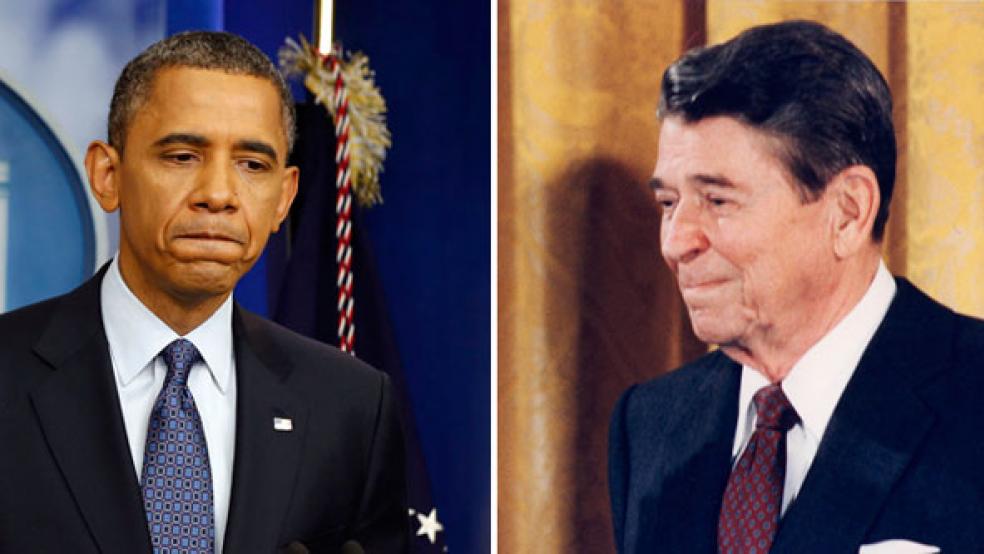Later today, President Barack Obama will deliver a widely-anticipated speech in Ohio in an attempt to “reframe” the debate over the economy. Insiders have told the media that Obama will not offer any new economic initiatives in the address – and in fact, that’s the entire point. The President will argue, much like another President did 30 years earlier, that the nation doesn’t need a change in direction, but simply to stay the course.

If that seems like a far cry from “Change,” one of Obama’s campaign slogans from four years ago, that’s because Obama still sees this argument as change from what preceded him. In the last few days, Obama has returned to the 2008 strategy of running against George W. Bush and painting his opponent as Bush’s doppleganger. That worked for Obama four years ago when he ran against John McCain in an era of Bush-fatigue and economic crisis. Now that Obama has to run with an economic record of his own, he and his campaign have come to the conclusion that the only way to “reframe” his economic policies is to cast them as a long crusade against Bush economics.
RELATED: Obama Takes Aim at GOP, Europe as Economy Sputters
Can Obama succeed in arguing that voters need to allow him more time for his policies to succeed? The contrasts between the two “stay the course” arguments might be instructive.
Ronald Reagan actually used the phrase “stay the course” during his first midterm elections in 1982. Hammered by a double-dip recession and skyrocketing unemployment figures in his first year as President, Reagan had to play defense on his economic policies. The jobless rate rose more than three full points between Reagan’s inauguration and the midterms from 7.4 percent to 10.8 percent, peaking exactly at the worst time for Republicans.
Democrats hit the campaign trail with the message that Reaganomics had failed, openly ridiculing “stay the course” as an absurdity. Reagan pushed back in much the same manner Obama will today, arguing that his policies had not had enough time to work, and that staying the course would bring economic prosperity. Reagan’s efforts led to mixed results; Democrats picked up 27 seats in the House to extend their majority to 103, but failed to wrest control of the Senate away from Republicans, who actually picked up a seat and extended their upper-chamber majority to eight. Faced with a status-quo result, Reagan continued his policies – and two years later, with unemployment falling dramatically and the American economy booming, he won a historic landslide victory for a second term in office.
Clearly, Obama will adopt Reagan’s strategy with the hope of duplicating Reagan’s success. However, there are clear differences between the two situations. Let’s start with the timeframe. Reagan had been in office less than two years when he made the “stay the course” argument. Democrats argued that Reagan had been given enough time for his policies to succeed, but didn’t convince enough voters. By the time Reagan got to his re-election campaign, he had already won the argument – and Obama has lost it.
Obama has had nearly four years for his policies to work, and they haven’t produced significant job creation, nor economic prosperity. By this time in the Reagan presidency, the US had produced five straight quarters of GDP growth of 6 percent or more, including three quarters above 8 percent. In contrast, Obama’s policies haven’t produced a quarter of growth of even 4 percent in his entire term, and the highest-performing quarter for Obama in the past two years barely hit 3 percent.
RELATED: The Game Plan that Lets Romney Beat Obama
Even the President that Obama wants to use as his rhetorical whipping post managed to do better when recovering from the 2000-2001 trough, which never went anywhere near as deep as the 1980-81 double-dip recession or the 2007-9 Great Recession. The GDP growth rate hit 6.7 percent in the third quarter of 2003 after the second round of tax cuts took effect, and even three years later managed to get up to 5.1 percent before the economy significantly slowed.
Even on the jobless rate, the context between Reagan, Bush, and Obama diverge – and not to Obama’s favor. While unemployment spiked dramatically under Reagan, it didn’t result in an outflow of workers from the workforce. The civilian population participation rate actually went up from 63.9 percent at the start of Reagan’s term to 64.2 percent at the midterms. By the election in 1984, it rose to 64.5 percent, and rose rapidly to 66.2 percent by the end of Reagan’s second term. In Bush’s first term, the rate went from 67.2 percent -- nearly its historical peak – to 65.8 percent, and ended in his second term at 65.7 percent, when Obama took the reins.
In contrast, Obama’s policies have resulted in a historic exodus from the workforce. By the time of the recovery, four months after the passage of Obama’s stimulus bill, the unemployment rate was 9.5 percent and the participation rate still at 65.7 percent.
Three years later, the unemployment rate has dipped to 8.2 percent, but the participation rate has actually dropped below the level seen during Reagan’s “stay the course” argument to 63.8 percent. That actually represents an improvement from the previous month, which hit a 30-year low at 63.6 percent. The only reason the unemployment rate isn’t in double digits is because millions of former workers have despaired of finding work to the point where they no longer count in the statistics.
That’s the greatest contrast between Reagan and Obama. While Obama ran in 2008 as the figure of “hope and change,” his reframing speech today will solidify his standing in 2012 as the candidate of inertia and despair. Reagan’s policies of economic freedom may have needed more than two years to fully transform the American economy, but voters in 1982 could see light at the end of the tunnel. Americans had actual hope for real change. That’s the reason that “stay the course” worked for Reagan, and why it won’t for Obama.






